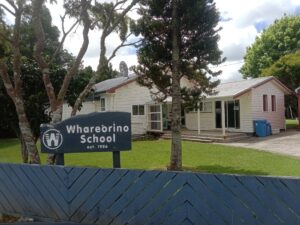
A remote school serving the community for almost a century.
Environmental education plays an important role in fostering a sense of kaitiakitanga and empowering tamariki to care for their environment. Enviroschools facilitators strive to support the schools they work with to the best of their ability, recognising that every school and community has its unique strengths, challenges, and opportunities. They aspire to tailor their approaches to ensure each school feels empowered and resourced to make meaningful progress on their sustainability journey. Like many remote schools, Whareorino School (rural Waitomo) experiences challenges to accessing Enviroschools facilitation and other Enviroschools opportunities due to their location. In 2024, Enviroschools Regional Coordinator Michelle Daly suggested trialling ‘remote facilitation’ for Whareorino and several other remote schools in rural Waitomo, building on strengths and learnings from hybrid facilitation established during the COVID-19 restrictions.
Current situation
Whareorino School Principal, Wendy, and Facilitator, Cami, began exploring what meaningful remote facilitation might look like for their school. Together, they developed a plan to engage students in Me in My Environment and Vision Mapping, grounding aspects of the Enviroschools programme, through weekly Zoom connections. With thoughtful planning and acknowledging how e-relationships require different practices to establish and grow, committing to regular weekly connection was considered essential – not only for supporting the students’ Enviroschools mahi, but it also reflected a more equitable approach to their Enviroschools journey.
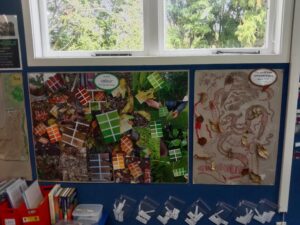
Recording observations from experiential activities and deepening learning.
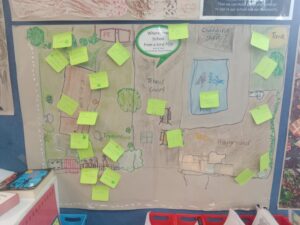
The vision map capturing aspects of the school environment and ideas for the future.
The students expressed an interest in learning about the Whareorino Tunnel, a beautiful but mysterious local landmark, and they wanted to create a sign to share knowledge about it with visitors. They were also keen to utilise their Enviroschools journey as an opportunity for education through nature and EOTC (Education Outside The Classroom)
Explore alternatives
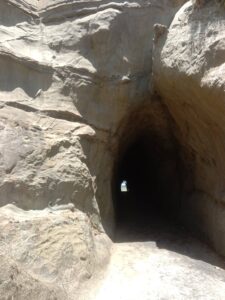
The view through the tunnel.
Wendy and Cami developed a plan for the term that blended outdoor learning with classroom activities, which were introduced, contextualised and then reflected on each week via Zoom. The weekly sessions were designed to deepen students’ engagement with nature, their school and local area, with each session building on the previous one, and each week adding different ‘layers’ to their Vision Map. Upcoming activities were discussed in the Zoom call, with any resources being sent ahead of the session via email (except for one activity, which was sent via post, for the novelty!).
The outdoor nature connection activities included “worms eye view” and “birds eye view” activities, scavenger hunts, leaf rubbings, species identification, with each task linked to the bigger picture of understanding their local environment and designing their sign for the Whareorino Tunnel. Follow-up activities in the classroom revolved around documenting their activities, deepening their learning through writing, maths and arts, and exploring different related kaupapa.
Take action
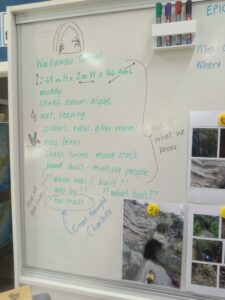
Capturing research and thinking about the tunnel.
As the weeks progressed, the students began to create a map of their school grounds, adding layers of information to reflect their growing understanding. They mapped physical features, identified their favourite places, different flora and fauna species, and explored the different colours and patterns found in nature. These activities are helping inform the artistic design for their tunnel sign, while their research (including reading online and printed resources, connecting with local experts, and site visits to the tunnel itself) have informed the development of the sign’s information content.
Principal Wendy used the activities as part of learning across the curriculum including maths (measuring tunnel dimensions, drawing to scale and mapping, nature patterns and repetition), reading (researching the Whareorino Tunnel and learning about worms), writing (reflecting on activities, preparing sign content), and arts (sketching the tunnel, drawing different plant and animal species, using colours).
As an exception to the ‘remote’ part of facilitation, just before the school year ended, they celebrated their learning with an in-person visit from Cami. This visit allowed students to share their work in person, show Cami the tunnel that inspired so much of their work, and meant they could add the final layer of their Vision Map together – this involved identifying all the spaces where they are currently taking environmental action, and brainstorm ‘next steps’ for their sustainability journey.
Reflect on change
This approach to remote facilitation felt like an effective way to engage students and support their learning despite the school’s remote geographical location. It provided opportunities for consistent engagement and connection, while also giving students the flexibility to work independently and together, both in and out of the classroom.
The frequent connection via Zoom meant a strong sense of whanaungatanga developed, and it ensured students had access to Enviroschools resources and support regularly. As a Facilitator, Cami is excited about how this facilitation model opens up possibilities for other remote schools to engage with Enviroschools in a meaningful way.
Looking ahead, Whareorino School plans to continue the sign design project in 2025, and will also be focusing on food growing and their maara kai. They have recently joined the Garden to Table programme, and they hope to adapt and adopt a remote facilitation model to support this learning as well. Enviroschools Facilitator Cami is connecting with Garden to Table facilitators to explore how they can work together to offer an engaging and holistic learning programme that is mutually supportive of the two programmes and Whareorino School.